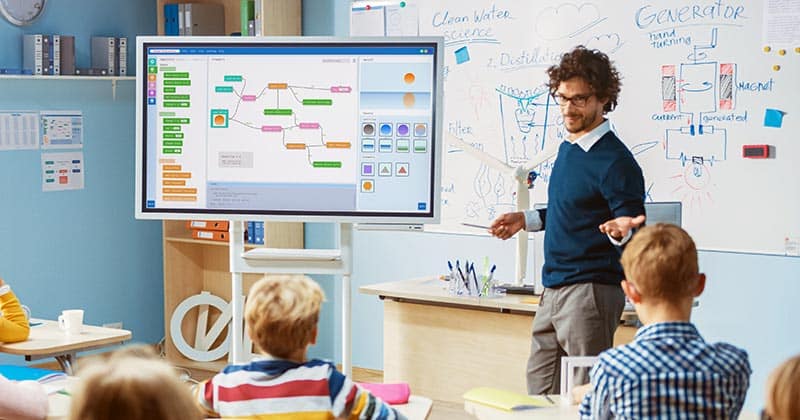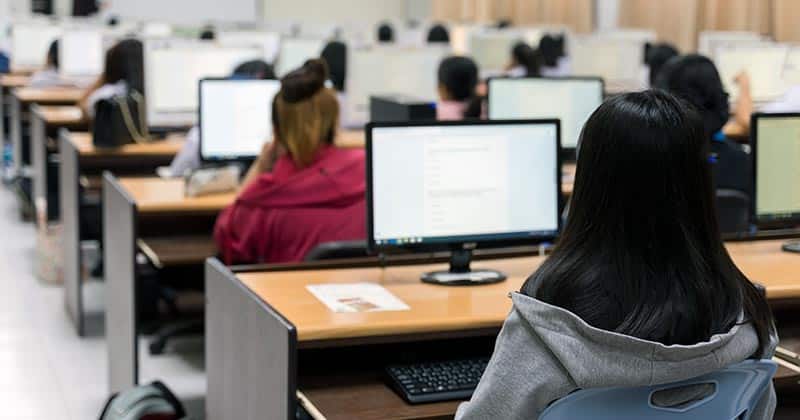Student learning is an area with enormous potential to benefit from information technology. Information dissemination is, after all, a core strength of today’s technologies. And digital technology offers versatile platforms to streamline classroom teaching.
While technology unlocks innovation opportunities, blended teaching and learning are not without disadvantages. What are the downsides that come with the powers and benefits of technology?
Debate is still going on concerning potential harm from integrating technology into the classroom. Let’s look at both sides by discussing the advantages and disadvantages of students accessing computers and digital information.
Advantages of Technology in Education
By offering digital tools and learning platforms, technology offers great advantages in school education. Students have more information at their fingertips and build technology skills. Tech can do some tasks equally or better than teachers, including administration, data gathering and supporting self-direct learning. Here are the top five pros to technology in the classroom.
1. Access high-quality, current information

Modern technology is fantastic when it comes to making information available to everyone. In a classroom setting, getting the most up-to-date data helps ensure the best educational experience. Teachers are also able to use or direct students towards trusted sources to ensure accurate information.
Students are also able to assimilate information more efficiently with the interactive presentation that digital technology allows. Instead of reading through text sequentially, the teacher or student can navigate information on a topic using hyperlinks, tabs, accordions, etc. References can be checked immediately as well.
Classroom technology definitely beats paper textbooks for accessing relevant information quickly. The trick is to place structure around activities to maintain focus and ensure the class is covering the same material. The need to keep everyone on the same page so to speak is a limiting factor in the use of technology for gaining information.
2. Gather student performance metrics easily

A clear and powerful advantage of using technology in education is that it allows teachers to perform their job better. The automatic collection of data in digital testing and learning environments has the benefits of: allowing more student performance data to be collected, freeing teachers from repetitive grading exercises, and providing instant feedback to students.
Platforms that yield data analytics can pinpoint the areas where each student is having most difficulty. Performance information allows instructors to quickly adjust teaching strategies and the syllabus according to the data gathered and analyzed.
When a given learning goal can be achieved with technology or traditional methods with about equal effectiveness, the technology-based approach may be preferred just because of the data advantages. Once in this digital environment, the technology and instructional content may be improved over time, leaving traditional instruction techniques further and further behind.
3. Customized learning
One of the biggest advantages of using technology in the classroom is its ability to provide customized learning opportunities. Tools like Khan Academy and DreamBox adjust difficulty levels based on student responses, helping each learner progress at their own pace.
AI-driven platforms, such as ChatGPT, take this even further by offering personalised explanations and adaptive feedback. These tools can support students who need extra practice while providing more advanced challenges for those ready to move ahead.
Interactive platforms can also track progress and identify gaps quickly. For example, AI tools can analyse student performance and suggest targeted resources or exercises. This kind of support helps keep students engaged and builds their confidence by meeting their individual needs. With the right guidance, AI and other technologies can make learning more efficient and meaningful.
4. Students learn technology skills

Using technology in the classroom naturally increases opportunities for students to learn technology skills. While it’s possible to take all but the simplest IT skills out of a lesson, keeping some technical challenges in there is healthy for student development. After all, we live in a digital world and have things like AI assistance, virtual offices and working online from home.
Children are fast learners when it comes to most things but especially with technology. Given the chance, they’ll quickly build computer operation skills and digital literacy. Examples of skills they’ll learn include keyboard awareness, logging in and password protection, navigating apps, setting preferences, online document sharing, and using standard software such as text editors and spreadsheet workbooks.
Teachers can offer exercises that give pupils the opportunity to test and expand their capabilities. For example, you can give students freedom in how they present project results. The smart ones, who could perhaps become IT professionals in the future, will find and deploy internet resources, such as graphics or charting software, to enhance the presentation.
5. Improved student participation and engagement

Students generally love technology and introducing it is a way to boost engagement. Mixing up traditional instruction styles with technology makes the class less predictable and the learning environment more dynamic.
Examples of how teachers can inject technology are to: direct students to online resources, present short videos, use interactive software, make digital presentations, and ask students to create digital content themselves.
Online platforms are often flexible in allowing you to exercise your creativity. You can, for instance, customize quizzes to make them more engaging and competitive. Any good resources you find online might be useful additions to the lesson. The possibilities are limitless.
You can also apply technology to get more information from reserved students. If you need to ask the opinion of everyone regarding a topic or even a simple question, why not use an online polling platform? This way, even quiet students who normally wouldn’t want to speak in the classroom will participate.
6. Automate repetitive tasks

Teaching can include tedious tasks such as keeping track of attendance, recording quiz scores and noting tasks completed. With the present technology available, such tasks can now be partially or fully automated. This can unlock time teachers are able to divert to substantive teaching endeavors.
Existing technology can be used to help teachers in several areas: planning lessons, assessing students, grading homework, giving feedback and administrative paperwork.
Jill Barshay
Implementing technology is not a costless exercise however and the effectiveness depends on how well software is programmed and made easy to use. But, over time, we can expect the work of teachers to become more streamlined. Instructors will have fewer administrative tasks and more time to capitalize on human strengths, such as making connections, inspiring students and creating a sense of shared purpose.
Disadvantages to Technology in the Classroom
The recency of many innovations means we’re still grappling with how best to incorporate technology in schools. Educators may lack the time and knowledge to implement tech effectively. Using technology without sufficient care can produce poorer learning outcomes and cause students to miss out on social interaction. These are key cons of technology in the classroom and online education.
1. Faster but less memorable learning

While the lightning pace with which technology operates may seem like a clear benefit, experienced educators are actually wary of this aspect. Devices and learning apps are able to function faster than the corresponding learning speed of the human mind. Students may gloss over material, missing texture and depth along the way.
Proper and coherent cognitive thought takes time. Otherwise, engagement can be drastically reduced. It’s for this reason experts are suggesting we modify media use, such as how videos are presented, to slow down and allow for more rumination and contemplation.
The simple act of writing something by hand has slowing, stimulatory effects that brain research has shown to aid both learning and memorization. Although efficient, typing is repetitive as each keystroke is almost the same action. Writing by hand is more challenging, intricate and slower, allowing your brain to form more “hooks” to imprint thoughts.
2. Technology can be distracting

Devices such as laptops and tablets in the classroom are bound to become sources of distraction to students. This is especially true if the software doesn’t prevent access to apps unrelated to lessons, quizzes and other educational activities.
A need exists for appropriate restrictive measures on gadgets in education to ensure they further learning goals and aren’t used, for example, to play games or use social media for pure entertainment. You can be sure that some badly behaved students will always try to use technology for fun instead of the intended purpose.
A problem here is that high school students may be more tech savvy than their teachers. One technique students use to access out-of-bounds sites is to go to a proxy site that delivers content from other sites without the student technically visiting those sites. Another method to bypass a school firewall is to use a virtual private network (VPN) to encrypt browsing data so the student’s internet activities can’t be monitored.
3. Less direct social interaction

The apparent way in which technology excises social interaction is another cause for concern. Students have less need to verbally communicate and interact with their teachers and one another when using technology. Online teaching and learning excludes face-to-face interaction altogether.
To address this, classroom teachers should ensure activities such as oral presentations, recitations and group work happen regularly. There needs to be a mindfulness that we’re trying to prepare well-rounded people for adulthood.
For students addicted to gaming or social media, school might actually be a place where they get some downtime from tech. It’s up to teachers to identify when students are spending too much time with their heads buried in devices. When technology isn’t being used, students should be encouraged or pressed to show some life and interact.
4. Integrating tech is often time consuming

While technology could make the job of a teacher very easy in the future, we are not there yet. Devising effective lessons using digital technology can be challenging and time consuming. That’s why it’s important for educators to share their insights on how to effectively teach kids when there is technology in the classroom.
Showing up to your class and teaching by talking and interacting with students doesn’t require special preparation. But when you use technology heavily during a lesson, you’re normally going to have to prepare for that. Teachers taking advantage of technology have the same amount of face-to-face instruction time but may need to do more planning, placing an extra strain on their workload.
Online learning when classes are held remotely have shown the limitations of tech. Just trying to corral students, to ensure they’re all logged in and paying attention, is a challenge in itself. The quality of lessons suffers as educators grapple with tech while trying to meet the practical learning needs of students.

Thank you Beyonce
You guys feel faker than my love life.
This was helpfull
Upvote!!!!!!!!
My child has been influenced due to the bad technology. He was a nice 9 year old kid before he found out about the thug shaker from technology. He keeps saying “Im bout to blow.” Technology has effected our society. And the thug shaker is a prime example.
OKAY BOOMER!
This comment section be crazy yall.
i think ur over exaggerating
gangsta rap
The amount of privilege in this paragraph is nothing short of nauseating.
“Teachers can offer exercises that give pupils the opportunity to test and expand their capabilities. For example, you can give students freedom in how they present project results. The smart ones, who could perhaps become IT professionals in the future, will find and deploy internet resources, such as graphics or charting software, to enhance the presentation.”
Oh wow, just wow… “The smart ones”, you mean the ones that sit still, eyes on you, have stable households, technology access at home, maybe even only from this country…
Do better future educators, do better….
Everyone in a classroom should be expected to pay attention, no matter their background. You don’t have to be privileged to do it. And every child should be given the opportunity to reach their potential – no ceilings.
chat gpt cookin
Some of us knew how to write before Chat GPT came along.
go to sleep
im a 12 year old sacred heart student and im reading your comments for a debate thank you so much 12\10\2023
Technology is very bad. Technology reminds me of the turbunence, strapping down your seatbelts, thug shaker, and people getting addicted to their phones, whenever i go in public people start doing turbulence, and always yelling out stuff and it influenced our society very big.
ok boomer
Stop being rude.
bro why
Travis Scott in da building
Technology can be a distraction for students, making it difficult for them to focus on learning. For example, students may be more interested in checking social media on their devices than paying attention to the lesson. Also when students rely too heavily on technology, they may become less capable of solving problems or completing tasks without it. This can hinder their ability to develop critical thinking and problem-solving skills.
no you are wrong
ok
i think that it is not that it is not that bad to have a phone
Maybe so. However, the use of technology and electronic devices can have negative effects on concentration and the ability to write well-structured sentences. Everyone, including educators, need to find a balance and limit the use of technology to enhance academic performance.
pluh using ai
Technology needs to be included to a certain degree but if we use it in every aspect of learning, you will see more and more children suffering with ADHD, ADD, and other learning issues. I see it now with children as young as 8 years old walking around with smartphones!
The good news is there is no evidence in this study or anything else I’ve read that cell phone use would create ADHD
thats because there parents dont care if they have a phone. Its the 21st century its not back when you got hit with the birtch.
There are pros and cons to everything, that’s why everything should be used in a controlled way. This is true nothing can replace the conventional method of teaching, but we can make it more interesting and better for students with a little use of tech. Like the use of animation, quiz polls, etc. So everything is cool until it is used in a particular way.
I would like to point out that you’re contradicting yourself on the Pro#4 with the interaction of a student via tech, and with the Con #3, that a student needs to interact with oral participation. The Pro #4 would discourage oral participation, which I believe is huge asset for all students. A student should be encouraged and helped with speaking out on different discussions. Teaches would call on me, even though they knew I didn’t like it, but it helped me get over my shyness. I hated speech in high school, but I did it and thank God for it. It has helped me tremendously.
That’s a good point Billiam. We shouldn’t lose the art of conversation and talking in person. Using technology to engage students is a balancing act.
I think it’s imperative that kids learn technology. Just don’t abandon everything. For example, we don’t use quills and inkpots (or fountain pens for that matter), but we should still teach kids to write with pens and pencils. That includes cursive, which is proven to help kids’ learning. There are grey areas though. One of them is calculators. We don’t teach kids how to use slide rules, but should we abandon calculators for certain situations? Then there are things that have completely been abandoned, but for no good reason. Why can’t kids tell time with non-digital clocks?
I can agree on most of your points. My question would be, when do we introduce students to technology? Call me old fashioned, but I believe that the task of learning simple math (1-3 digit computations), parts of speech, and sentence structure should be taught without the use of any type of technology. As students progress, I think technology is a great thing to interject into education. I do believe, however, this should be minimalized until about fifth grade. Students taking assessment test need to know how to write instead of just clicking on an answer. Calculators were never allowed in school until junior high when I attended. There are many students, in the school where I work, that will not write because they do not know how to form the letters on paper. Many times the students who do know how to write, have horrible handwriting because they do not write every day.
Yes, technology is wonderful, but at what age should it be introduced in order for students to be able to succeed before technology is used?
This is how I see technology in the classroom: you have to use a hybrid model because there is no escaping how ingrained technology is in our lives and even more in the students’ lives. I would argue that in some cases the students are ahead of their teachers when it comes to being tech-savvy and understanding where things are headed. However, there are traditional skills that are overlooked far too much including reading from books, writing (printing and cursive), and doing research without a computer. Add these items to your article and I can’t think of any better description of the pros and cons of using technology in classrooms.
just play fornite